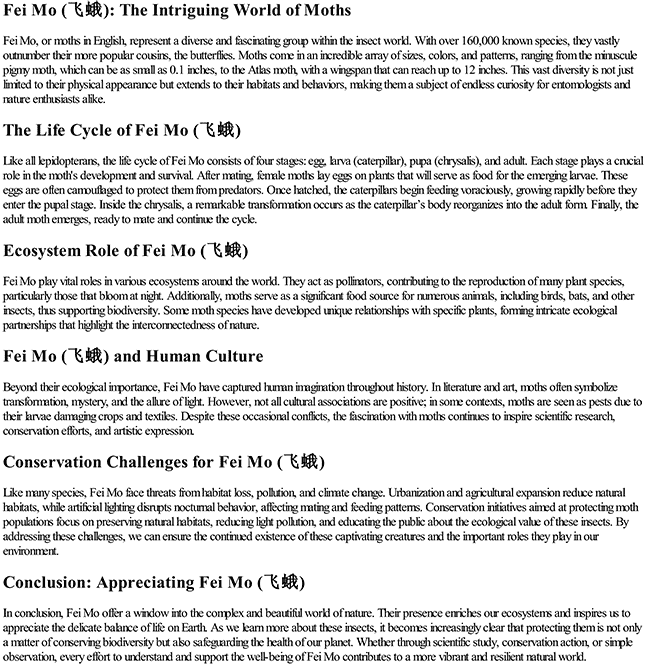飞蛾的拼音-免费下载(word版可打印,PDF版可打印)
Fei Mo (飞蛾): The Intriguing World of Moths
Fei Mo, or moths in English, represent a diverse and fascinating group within the insect world. With over 160,000 known species, they vastly outnumber their more popular cousins, the butterflies. Moths come in an incredible array of sizes, colors, and patterns, ranging from the minuscule pigmy moth, which can be as small as 0.1 inches, to the Atlas moth, with a wingspan that can reach up to 12 inches. This vast diversity is not just limited to their physical appearance but extends to their habitats and behaviors, making them a subject of endless curiosity for entomologists and nature enthusiasts alike.
The Life Cycle of Fei Mo (飞蛾)
Like all lepidopterans, the life cycle of Fei Mo consists of four stages: egg, larva (caterpillar), pupa (chrysalis), and adult. Each stage plays a crucial role in the moth's development and survival. After mating, female moths lay eggs on plants that will serve as food for the emerging larvae. These eggs are often camouflaged to protect them from predators. Once hatched, the caterpillars begin feeding voraciously, growing rapidly before they enter the pupal stage. Inside the chrysalis, a remarkable transformation occurs as the caterpillar’s body reorganizes into the adult form. Finally, the adult moth emerges, ready to mate and continue the cycle.
Ecosystem Role of Fei Mo (飞蛾)
Fei Mo play vital roles in various ecosystems around the world. They act as pollinators, contributing to the reproduction of many plant species, particularly those that bloom at night. Additionally, moths serve as a significant food source for numerous animals, including birds, bats, and other insects, thus supporting biodiversity. Some moth species have developed unique relationships with specific plants, forming intricate ecological partnerships that highlight the interconnectedness of nature.
Fei Mo (飞蛾) and Human Culture
Beyond their ecological importance, Fei Mo have captured human imagination throughout history. In literature and art, moths often symbolize transformation, mystery, and the allure of light. However, not all cultural associations are positive; in some contexts, moths are seen as pests due to their larvae damaging crops and textiles. Despite these occasional conflicts, the fascination with moths continues to inspire scientific research, conservation efforts, and artistic expression.
Conservation Challenges for Fei Mo (飞蛾)
Like many species, Fei Mo face threats from habitat loss, pollution, and climate change. Urbanization and agricultural expansion reduce natural habitats, while artificial lighting disrupts nocturnal behavior, affecting mating and feeding patterns. Conservation initiatives aimed at protecting moth populations focus on preserving natural habitats, reducing light pollution, and educating the public about the ecological value of these insects. By addressing these challenges, we can ensure the continued existence of these captivating creatures and the important roles they play in our environment.
Conclusion: Appreciating Fei Mo (飞蛾)
In conclusion, Fei Mo offer a window into the complex and beautiful world of nature. Their presence enriches our ecosystems and inspires us to appreciate the delicate balance of life on Earth. As we learn more about these insects, it becomes increasingly clear that protecting them is not only a matter of conserving biodiversity but also safeguarding the health of our planet. Whether through scientific study, conservation action, or simple observation, every effort to understand and support the well-being of Fei Mo contributes to a more vibrant and resilient natural world.

点击下载 飞蛾的拼音Word版本可打印
点击下载 飞蛾的拼音pdf版本可打印
